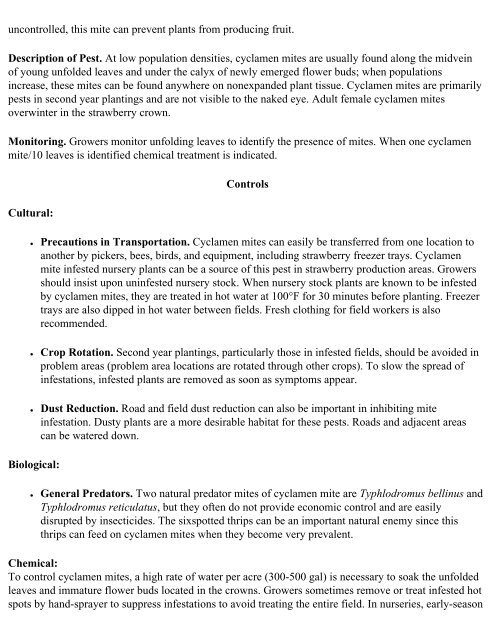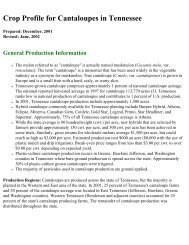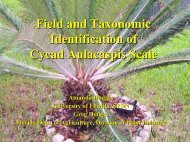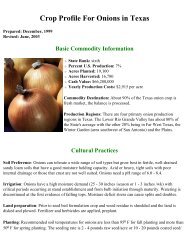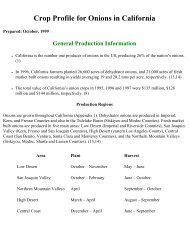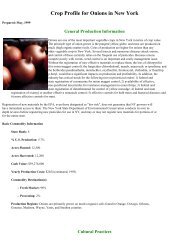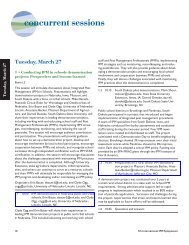Crop Profile for Strawberries in California - Regional IPM Centers
Crop Profile for Strawberries in California - Regional IPM Centers
Crop Profile for Strawberries in California - Regional IPM Centers
You also want an ePaper? Increase the reach of your titles
YUMPU automatically turns print PDFs into web optimized ePapers that Google loves.
uncontrolled, this mite can prevent plants from produc<strong>in</strong>g fruit.<br />
Description of Pest. At low population densities, cyclamen mites are usually found along the midve<strong>in</strong><br />
of young unfolded leaves and under the calyx of newly emerged flower buds; when populations<br />
<strong>in</strong>crease, these mites can be found anywhere on nonexpanded plant tissue. Cyclamen mites are primarily<br />
pests <strong>in</strong> second year plant<strong>in</strong>gs and are not visible to the naked eye. Adult female cyclamen mites<br />
overw<strong>in</strong>ter <strong>in</strong> the strawberry crown.<br />
Monitor<strong>in</strong>g. Growers monitor unfold<strong>in</strong>g leaves to identify the presence of mites. When one cyclamen<br />
mite/10 leaves is identified chemical treatment is <strong>in</strong>dicated.<br />
Cultural:<br />
Controls<br />
● Precautions <strong>in</strong> Transportation. Cyclamen mites can easily be transferred from one location to<br />
another by pickers, bees, birds, and equipment, <strong>in</strong>clud<strong>in</strong>g strawberry freezer trays. Cyclamen<br />
mite <strong>in</strong>fested nursery plants can be a source of this pest <strong>in</strong> strawberry production areas. Growers<br />
should <strong>in</strong>sist upon un<strong>in</strong>fested nursery stock. When nursery stock plants are known to be <strong>in</strong>fested<br />
by cyclamen mites, they are treated <strong>in</strong> hot water at 100°F <strong>for</strong> 30 m<strong>in</strong>utes be<strong>for</strong>e plant<strong>in</strong>g. Freezer<br />
trays are also dipped <strong>in</strong> hot water between fields. Fresh cloth<strong>in</strong>g <strong>for</strong> field workers is also<br />
recommended.<br />
● <strong>Crop</strong> Rotation. Second year plant<strong>in</strong>gs, particularly those <strong>in</strong> <strong>in</strong>fested fields, should be avoided <strong>in</strong><br />
problem areas (problem area locations are rotated through other crops). To slow the spread of<br />
<strong>in</strong>festations, <strong>in</strong>fested plants are removed as soon as symptoms appear.<br />
● Dust Reduction. Road and field dust reduction can also be important <strong>in</strong> <strong>in</strong>hibit<strong>in</strong>g mite<br />
<strong>in</strong>festation. Dusty plants are a more desirable habitat <strong>for</strong> these pests. Roads and adjacent areas<br />
can be watered down.<br />
Biological:<br />
● General Predators. Two natural predator mites of cyclamen mite are Typhlodromus bell<strong>in</strong>us and<br />
Typhlodromus reticulatus, but they often do not provide economic control and are easily<br />
disrupted by <strong>in</strong>secticides. The sixspotted thrips can be an important natural enemy s<strong>in</strong>ce this<br />
thrips can feed on cyclamen mites when they become very prevalent.<br />
Chemical:<br />
To control cyclamen mites, a high rate of water per acre (300-500 gal) is necessary to soak the unfolded<br />
leaves and immature flower buds located <strong>in</strong> the crowns. Growers sometimes remove or treat <strong>in</strong>fested hot<br />
spots by hand-sprayer to suppress <strong>in</strong>festations to avoid treat<strong>in</strong>g the entire field. In nurseries, early-season


